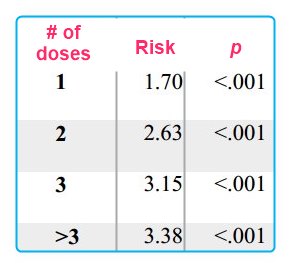More COVID vaccinations, more infections - Cleveland Clinic
Effectiveness of the Coronavirus Disease 2019 (COVID-19) Bivalent Vaccine
medRxiv preprint Dec 19, 2022 [doi: https://doi.org/10.1101/2022.12.17.22283625]
Nabin K. Shrestha,1l [[email protected]]; Patrick C. Burke,2 Amy S. Nowacki,3 James F. Simon,4 Amanda Hagen,5 Steven M. Gordon
1 departments of Infectious Diseases, 2Infection Prevention, Quantitative Health Sciences, 4Enterprise Business Intelligence, and Occupational Health, Cleveland Clinic, Cleveland, Ohio, USA.


Summary: Among 51011 working-aged Cleveland Clinic employees, the bivalent COVID-19 vaccine booster was 30% effective in preventing infection , during the time when the virus strains dominant in the community were represented in the vaccine.
Background. The purpose of this study was to evaluate whether a bivalent COVID-19 vaccine protects against COVID-19.
Methods. Employees of Cleveland Clinic in employment on the day the bivalent COVID-19 vaccine first became available to employees, were included. The cumulative incidence of COVID-19 was examined over the following weeks. Protection provided by vaccination (analyzed as a time-dependent covariate) was evaluated using Cox proportional hazards regression. The analysis was adjusted for the pandemic phase when the last prior COVID-19 episode occurred, and the number of prior vaccine doses received.
Results. Among 51011 employees , 20689 (41%) had had a previous documented episode of COVID-19, and 42064 (83%) had received at least two doses of a COVID-19 vaccine. COVID-19 occurred in 2452 (5%) during the study. Risk of COVID-19 increased with time since the most recent prior COVID-19 episode and with the number of vaccine doses previously received. In multivariable analysis, the bivalent vaccinated state was independently associated with lower risk of COVID-19 (HR, .70; 95% C.I., .61 -.80), leading to an estimated vaccine effectiveness (VE) of 30% (95% CI, 20-39%).
Compared to last exposure to SARS-CoV-2 within 90 days, last exposure 6-9 months previously was associated with twice the risk of COVID-19, and last exposure 9-12 months previously with 3.5 times the risk.
Conclusions. The bivalent COVID-19 vaccine given to working-aged adults afforded modest protection overall against COVID-19, while the virus strains dominant in the community were those represented in the vaccine.
📄 Download the PDF from Vitamin D Life
This preprint was discussed in Dr. Campbell video - Jan 4, 2023
Video was removed by YouTube the next day
: Dr. Campbell asked why this sort of study was not done years ago by the CDC, FDA, etc.
Studies with similar conclusions in Vitamin D Life
COVID variants in US evade bivalent vaccination by 3X to 13X – Cell Dec 13, 2022
The more COVID vaccinations you get, the More Likely you’ll get COVID - Oct 2022
6X increase in excess deaths of children since vaccinations were started - Oct 2022
Regional Excess Deaths strongly associated with COVID vaccination rate (UK) – Sept 2022
Pandemic of the Boosted: UK Data Reveal Problem With COVID Vaccinations - July 2022
